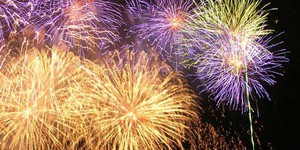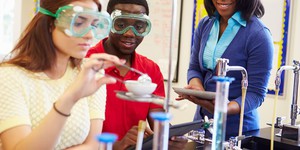Summary
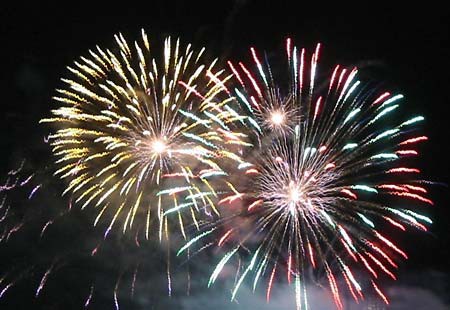
Introduction
Have you ever watched a fireworks show and wondered how all the different colors — amazing reds, yellows, oranges, blues, purples, greens, and more — are made? The color, or colors, that a firework makes depends on what color-producing chemicals are in the firework. These chemicals are various metal salts that burn when the firework goes off, and burning the metals is what makes the colors. Different metals give off different, specific colors. In this science activity, you will get to burn some metal salts at home to investigate what colors they make. Then, at the next fireworks show, you can impress friends and family with your knowledge of what may be causing some of the colors they see!
Materials
- Chemicals to burn, specifically table salt and copper sulfate.
- Table salt is technically called sodium chloride.
- Copper sulfate is available through pet or aquarium stores to combat algae, or through home improvement stores as a root killer. Make sure the product is pure copper sulfate and that it is in powder or small crystals form.
- Alternatively, if you would like these chemicals plus two other colorful, hard-to-find metal salts and some safety equipment all in one convenient package, try the Rainbow Fire Kit from our partner Home Science Tools.
- Small plastic bag
- Bamboo skewers (at least 6)
- White glue
- Candle
- Matches or lighter
- Container of water
- An outdoor surface you can safely burn a candle on when it is dark outside (or twilight). Be sure it is in an open area to allow good air flow.
- Adult helper
- Recommended: Disposable gloves, dishwashing gloves are a fine alternative. These are for handling the copper sulfate.
- Recommended: Safety goggles
- Optional: Flashlight
- Optional: Masking tape and pen or marker to label the skewers with the chemical names
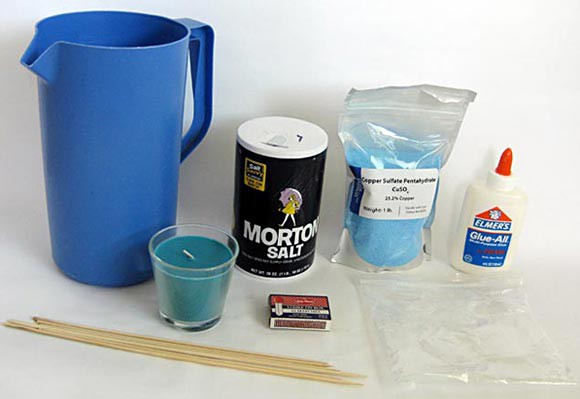 Image Credit: Teisha Rowland, Science Buddies / Science Buddies
Image Credit: Teisha Rowland, Science Buddies / Science Buddies
Disclaimer: Science Buddies participates in affiliate programs with Home Science Tools, Amazon.com, Carolina Biological, and Jameco Electronics. Proceeds from the affiliate programs help support Science Buddies, a 501(c)(3) public charity, and keep our resources free for everyone. Our top priority is student learning. If you have any comments (positive or negative) related to purchases you've made for science projects from recommendations on our site, please let us know. Write to us at scibuddy@sciencebuddies.org.
Prep Work
- When you burn the skewers, be sure to do it in an open, outdoor area and be careful not to breathe the fumes or smoke from the skewers.
- Adult supervision is needed when using fire, burning the skewers, and handling the chemicals.
- If you want, label the skewers with the names of the chemicals that you will be coating the skewers with. (If you are only testing table salt and copper sulfate, you will not need to label the skewers since it is easy to tell the difference between these chemicals as table salt is white and copper sulfate is blue.) You will be coating three skewers with each chemical. Make the labels by putting a piece of masking tape around the blunt end of the skewer, like a flag. With a pen or marker, write the name of a chemical name on each skewer's masking tape label.
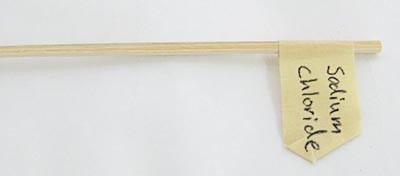 Image Credit: Teisha Rowland, Science Buddies / Science Buddies
Image Credit: Teisha Rowland, Science Buddies / Science Buddies
Instructions
- Pour a small amount of table salt (roughly one tablespoon) into a small plastic bag.
- Apply a thin layer of glue to the last one inch of the tip of a skewer. Just a little bit of glue is enough.
 Image Credit: Sandra Slutz, Science Buddies / Science Buddies
Image Credit: Sandra Slutz, Science Buddies / Science Buddies
- Dip the glue-coated tip of the skewer into the salt in the bag. Twist the skewer back and forth a bit to coat the skewer's tip with the salt. Set the skewer aside to dry.
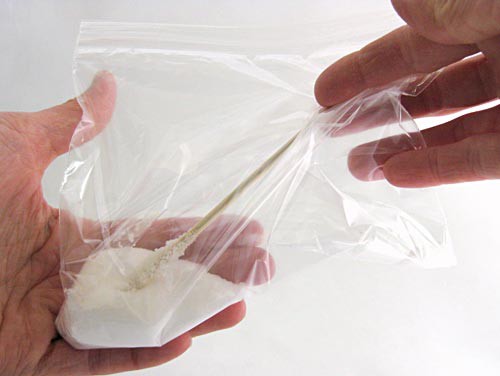 Image Credit: Teisha Rowland, Science Buddies / Science Buddies
Image Credit: Teisha Rowland, Science Buddies / Science Buddies
- Repeat this process with two more skewers so you have a total of three skewers that have their tips coated with salt.
- Next, have an adult coat three more skewers with copper sulfate. Read and follow all safety precautions on the packaging that the copper sulfate came in. Be careful not to let anybody breathe in any copper sulfate dust or get any on their skin or face. If desired, use disposable gloves and safety goggles. If not using gloves, be sure not to touch the copper sulfate. Coat the last one inch of the tip of a skewer in a thin layer of glue and dip the glue-coated tip into the bag of blue-colored copper sulfate, twisting it back and forth to coat the tip in copper sulfate.
 Image Credit: Sandra Slutz, Science Buddies / Science Buddies
Image Credit: Sandra Slutz, Science Buddies / Science Buddies
- Repeat this with two more skewers so that you have three total that are coated in copper sulfate.
- If you are using the Rainbow Fire Kit, repeat this process to have an adult coat other skewers with any additional chemicals you want to test (i.e., strontium chloride or boric acid). Be sure to follow all proper safety precautions when handling these chemicals. Coat three skewers with each chemical you want to test.
- Allow all of your skewers to dry. This will take about half an hour for each.
- When it is dark (or twilight) outside, take your candle, matches, and prepared skewers to an open area outside where you can safely burn a candle. Be sure there is good air flow. Also have a container of water with you as a safety precaution.
- Have an adult light the candle.
- Once the candle is burning well, carefully take out one of the prepared skewers and hold the chemical-coated end in the flame. Be sure not to breathe the fumes or smoke from the burning skewer!What color does the chemical burn? How does it compare to the normal color of the candle's flame?
- Tip: You may be able to see the chemical's color in the candle's flame, or by holding the skewer away from the candle (once the chemical has caught on fire) and looking at the flame on the chemical-coated end of the skewer.
- The skewer may also catch fire after a few moments. Simply remove it from the flame and blow it out, or extinguish it in the container of water.
- Repeat this process for the other chemical-coated skewers. (To help you distinguish which chemical you are burning, remember that the skewers coated in table salt will have white-coated tips, while the skewers coated in copper sulfate will have blue-coated tips.)Which color does the table salt (sodium chloride) burn? Which color does the copper sulfate burn? If you burn other chemicals, what color(s) do they burn?
Cleanup
- Be sure to extinguish the candle and the skewers when you are done with the activity. When you are sure they have been extinguished, you can dispose of the used chemical coated skewers in the garbage.
What Happened?
A typical flame will burn yellow/orange with a little bit of blue near the base of the wick. When you burned the skewer tip coated with sodium chloride, you should have seen that the flame on the sodium chloride was pure yellow/orange (without any blue). This is because when the metal sodium is burned, it makes intense yellow/orange light. When you burned the skewer tip coated with copper sulfate, you should have seen that the flame gained blue-green traces. This is because when the metal copper is burned, it makes bluish-green light. If you tested additional chemicals from the Rainbow Fire kit, you should have seen that the boric acid burned a vivid green and the strontium chloride burned red.
Today when we watch fireworks displays there are many colors represented but this was not always the case. From the time fireworks were invented (the earliest documentation is from around the 7th century C.E. in China) until the 1830s, all fireworks were either white or orange. Then, in the 1830s, the Italians discovered that adding metal salts to the fireworks mixture resulted in interesting colors, just like in the flame test in this science activity.
Digging Deeper
Colored flames are not just for fireworks displays; the same science that shows us a pretty colored flame allows astronomers to figure out what distant stars are made of (in other words, their atomic composition) by seeing what type of light is produced by the star. How does it work exactly? It comes down to atoms and energy.
All matter is made of atoms. Atoms have a nucleus that is surrounded by electrons. Electrons moving around the nucleus have certain amounts of energy, called energy levels. If electrons gain energy, they move from one energy level up to a higher level through distinct steps. Likewise, if electrons lose energy, they drop down to a lower energy level. The lost energy can be carried away in the form of heat or in the form of light (as a photon). Exactly how much energy is lost affects what kind of light is made, which we may perceive as a difference in the color of the light. Different types of atoms, or elements, have different gaps between their energy levels, which causes them to make light of different colors when they are burned and lose that energy.
Ask an Expert
For Further Exploration
- You could try this activity using other metals known to produce certain flame colors when burned. Check out the Science Buddies Rainbow Fire Science Project project idea for some ideas and do some research on flame tests. Be sure to always look into and follow all proper safety precautions when handling different chemicals and burning them. What colors do other metals make when burned?
Related Resources
Project Ideas
Links
- Blog Post: Iron Man 3 Out Today - Highlight the Science


